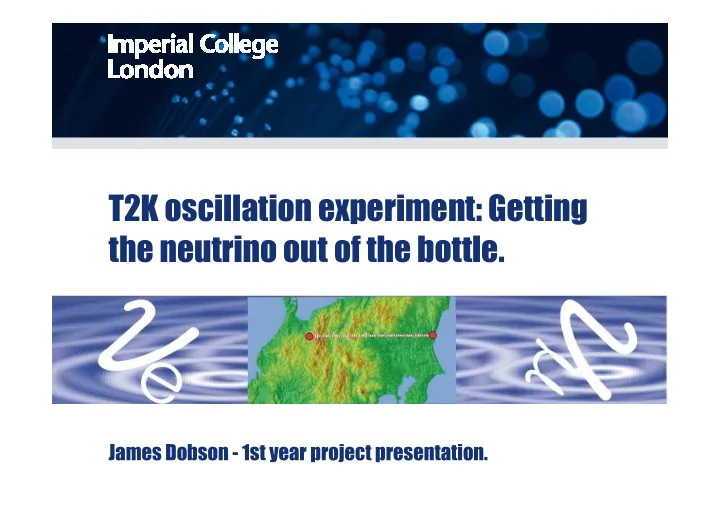

T2K oscillation experiment: Getting the neutrino out of the bottle. James Dobson - 1st year project presentation.
Outline of presentation. • Neutrino oscillations: A brief overview. • T2K: Experimental setup. • Neutrino event generators: What are they and why are they needed. • GENIE:An overview. Re-weighting and T2K specific flux driver. • Plan of attack and general direction of project. James Dobson - Imperial College 2
Neutrino oscillations. Have introduced seven new parameters Make new measurement or improve limit Improve on current James Dobson - Imperial College 3
Disappearance and appearance measurement. Oscillation formulae For both measurements need to characterise neutrino flux both before and after oscillation. James Dobson - Imperial College 4
Tokai to Kamioka (T2K) experimental setup. T2K long-baseline setup. Off-axis design: Narrower energy distribution Kamioka Tokai Highest intensity <-- 295km --> neutrino beam to date -> Higher statistics. Near Detector at 280m (ND280) p π Off-axis SuperK On-axis 295 km (2 km) 280 m 100 m 0 m James Dobson - Imperial College 5
Neutrino interaction generator. Need to understand the neutrino interactions in detectors at ~1GeV scale. So require a generator that models interaction of neutrinos with detector nuclei. James Dobson - Imperial College 6
Neutrino interaction generator (cont). Why is it difficult: • Hadronic interactions at the ~GeV scale. Physics very difficult to describe/unknown and often no theoretical models exist. • Have to deal with hadronisation, re-hadronisation. • Relies heavily on parametric models. Leads to re-weighting • When and where to apply what model. A lot of choice and often not clear. The generator simulates the primary interaction and outputs result to the rest of the detector simulation software. James Dobson - Imperial College 7
GENIE (Generates Events for Neutrino Interaction Exp). T2K is generator-agnostic. Can use a number of different generators including NUANCE, NEUT and GENIE. GENIE is already official generator for MINOS, NOvA experiments. Co-supervised by one of the creators of GENIE. Plus points of GENIE: Re-weighting • Well designed C++ code • T2K specific flux generator • Much effort gone into validation using external data • James Dobson - Imperial College 8
T2K specific flux driver. Specific flux driver. Using ND280 as an example. Throws an event by calculating interaction probability. Interaction probability for i th section of path. i i i i i Cross section Density for given weighted path neutrino and length. James Dobson - Imperial College 9 target, at E.
Re-weighting and error envelopes. Cross-section re-weighting exist at present. Future re-weighting schemes. Hadronisation and Intra-nuclear transport models. Much harder. James Dobson - Imperial College 10
Ways of using GENIE. 1) As a tool for the experiment. For monte-carlo studies. Re-weighting, calculating error envelopes due to dependency on parametric models. 2) Using data from experiment to fine tune parametric models. As a tool for testing new hadronic/intra-nuclear models. Deciding what models describe the physics over what range. James Dobson - Imperial College 11
Plan of attack. Immediate plan of attack: • Validating T2K specific flux driver. • Re-weighting for cross sections. Then developing other re-weighting schemes. • Working with Antonin Vacheret on MPPC’s General direction of project: • Assisting Costas Andreopolous, one of the creators, in the development of generator. • Using GENIE for physics studies of neutrino nucleus interactions. • Acting as mediator / interface between Imperial T2K group and GENIE creators. James Dobson - Imperial College 12
The End. James Dobson - Imperial College 13
James Dobson - Imperial College 14
ND280 Why ND280? Need to characterise flux before oscillations. Electron neutrino contamination. Imperial’s role. Heavily involved in the software for the ND280 detector: Detector simulation, Reconstruction, Analysis. Working on characterising MPPC’s. Now moving into a stage of testing >>1000 of them. James Dobson - Imperial College 15
BACKUP. James Dobson - Imperial College 16
Recommend
More recommend